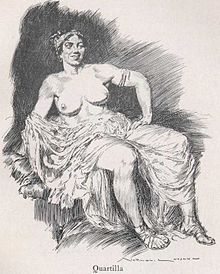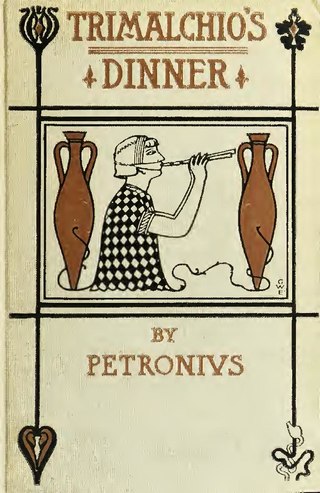
Trimalchio is a character in the 1st-century AD Roman work of fiction Satyricon by Petronius. He features as the ostentatious, nouveau-riche host in the section titled the "Cēna Trīmalchiōnis". Trimalchio is an arrogant former slave who has become quite wealthy as a wine merchant. The name "Trimalchio" is formed from the Greek prefix τρις and the Semitic מלך (melech) in its occidental form Malchio or Malchus. The fundamental meaning of the root is "King", and the name "Trimalchio" would thus mean "Thrice King" or "greatest King".
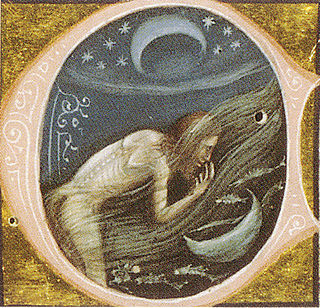
The picaresque novel is a genre of prose fiction. It depicts the adventures of a roguish but "appealing hero", usually of low social class, who lives by his wits in a corrupt society. Picaresque novels typically adopt the form of "an episodic prose narrative" with a realistic style. There are often some elements of comedy and satire. While the term "picaresque novel" was only coined in 1810, the picaresque novel originated in Imperial Rome during the 1st-2nd century CE, in particular with works such as the Satyricon of Petronius and later, and more particularly with authors such as Apuleius in Roman Numidia. It would see a revival in Spain during the Spanish Golden Age in 1554. Early Spanish contributors included Mateo Alemán and Francisco de Quevedo, who were influenced in particular by Apuleius' 2nd century work. Other notable ancient influences of the modern picaresque genre include Roman playwrights such as Plautus and Terence. The Golden Ass of Apuleius nevertheless remains, according to many scholars such as F. W. Chandler, A. Marasso, T. Somerville and T. Bodenmüller, the primary influence for the modern Picaresque genre. Subsequently, after the revival in Spain, the genre flourished throughout Europe for more than 200 years for the first time since the Roman period. It continues to influence modern literature.

Uncle Tom's Cabin; or, Life Among the Lowly is an anti-slavery novel by American author Harriet Beecher Stowe. Published in two volumes in 1852, the novel had a profound effect on attitudes toward African Americans and slavery in the U.S., and is said to have "helped lay the groundwork for the [American] Civil War".

The Satyricon, Satyriconliber, or Satyrica, is a Latin work of fiction believed to have been written by Gaius Petronius in the late 1st century AD, though the manuscript tradition identifies the author as Titus Petronius. The Satyricon is an example of Menippean satire, which is different from the formal verse satire of Juvenal or Horace. The work contains a mixture of prose and verse ; serious and comic elements; and erotic and decadent passages. As with The Golden Ass by Apuleius, classical scholars often describe it as a Roman novel, without necessarily implying continuity with the modern literary form.
Chariton of Aphrodisias was the author of an ancient Greek novel probably titled Callirhoe. However, it is regularly referred to as Chaereas and Callirhoe. Evidence of fragments of the text on papyri suggests that the novel may have been written in the mid 1st century AD, making it the oldest surviving complete ancient prose romance and the only one to make use of apparent historiographical features for background verisimilitude and structure, in conjunction with elements of Greek mythology, as Callirhoe is frequently compared to Aphrodite and Ariadne and Chaereas to numerous heroes, both implicitly and explicitly. As the fiction takes place in the past, and historical figures interact with the plot, Callirhoe may be understood as the first historical novel; it was later imitated by Xenophon of Ephesus and Heliodorus of Emesa, among others.

Willa Sibert Cather was an American writer known for her novels of life on the Great Plains, including O Pioneers!, The Song of the Lark, and My Ántonia. In 1923, she was awarded the Pulitzer Prize for One of Ours, a novel set during World War I.
Gaius Petronius Arbiter was a Roman courtier during the reign of Nero. He is generally believed to be the author of the Satyricon, a satirical novel believed to have been written during the Neronian era. He is one of the most important characters in Henryk Sienkiewicz' historical novel Quo Vadis (1895). Leo Genn portrays him in the 1951 film of the same name.
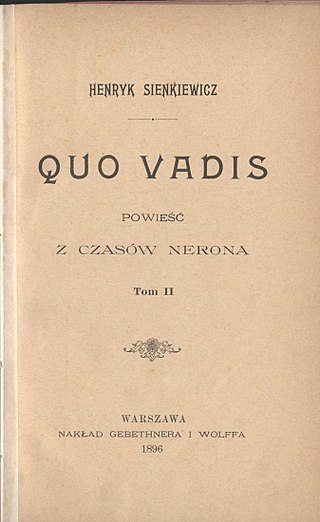
Quo Vadis: A Narrative of the Time of Nero is a historical novel written by Henryk Sienkiewicz in Polish.
The genre of Menippean satire is a form of satire, usually in prose, that is characterized by attacking mental attitudes rather than specific individuals or entities. It has been broadly described as a mixture of allegory, picaresque narrative, and satirical commentary. Other features found in Menippean satire are different forms of parody and mythological burlesque, a critique of the myths inherited from traditional culture, a rhapsodic nature, a fragmented narrative, the combination of many different targets, and the rapid moving between styles and points of view.

Impact play is a human sexual practice in which one person is struck by another person for the gratification of either or both parties which may or may not be sexual in nature. It is considered a form of BDSM.
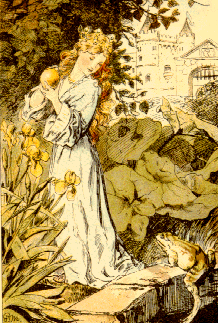
"The Frog Prince; or, Iron Henry" is a German fairy tale collected by the Brothers Grimm and published in 1812 in Grimm's Fairy Tales. Traditionally, it is the first story in their folktale collection. The tale is classified as Aarne-Thompson type 440.

Fellini Satyricon, or simply Satyricon, is a 1969 Italian surreal historical film written and directed by Federico Fellini and loosely based on Petronius's work Satyricon, written during the reign of Emperor Nero and set in Imperial Rome. The film is divided into nine episodes, following Encolpius and his friend Ascyltus as they try to win the heart of a young boy named Gitón within a surreal and dreamlike Roman landscape.
The Milesian tale is a genre of fictional story prominent in ancient Greek and Roman literature. According to most authorities, a Milesian tale is a short story, fable, or folktale featuring love and adventure, usually of an erotic or titillating nature.
Petronius's Satyricon, the only extant realistic Classical Latin novel, survives in a very fragmentary form. Many readers have wondered how the story would begin and end.
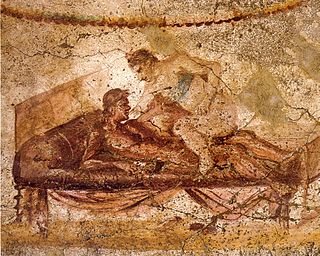
Prostitution in ancient Rome was legal and licensed. Men of any social status were free to engage prostitutes of either sex without incurring moral disapproval, as long as they demonstrated self-control and moderation in the frequency and enjoyment of sex. Brothels were part of the culture of ancient Rome, as popular places of entertainment for Roman men.
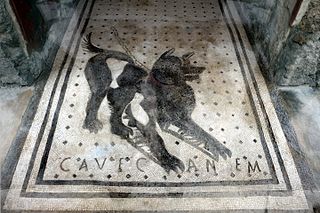
Beware of the dog is a warning sign posted at the entrance to a building or other private area indicating that a dangerous dog is within. Such signs may be placed to deter burglary even if there is no dog, or if the dog is not actually a competent guard dog.

The Cumaean Sibyl was the priestess presiding over the Apollonian oracle at Cumae, a Greek colony near Naples, Italy. The word sibyl comes from the ancient Greek word sibylla, meaning prophetess. There were many sibyls throughout the ancient world. Because of the importance of the Cumaean Sibyl in the legends of early Rome as codified in Virgil's Aeneid VI, and because of her proximity to Rome, the Cumaean Sibyl became the most famous among the Romans. The Erythraean Sibyl from modern-day Turkey was famed among Greeks, as was the oldest Hellenic oracle, the Sibyl of Dodona, dating to the second millennium BC according to Herodotus, favored in the east.
Karl Ernst Bürger was a German classical scholar of the late 19th century, who made significant contributions to the critical study of the Ancient Greek and Roman Novel, thereby helping to establish the field as a major area of study within Classical Philology.
Beth Severy-Hoven is Professor of the Classical Mediterranean and Middle East at Macalester College. She is an expert in Roman history and archaeology, and gender and sexuality in antiquity.

Howling is a vocal form of animal communication seen in most canines, particularly wolves, coyotes, foxes, and dogs, as well as cats and some species of monkeys. Howls are lengthy sustained sounds, loud and audible over long distances, often with some variation in pitch over the length of the sound. Howling is generally used by animals that engage in this behavior to signal their positions to one another, to call the pack to assemble, or to note their territory. The behavior is occasionally copied by humans, and has been noted to have varying degrees of significance in human culture.
